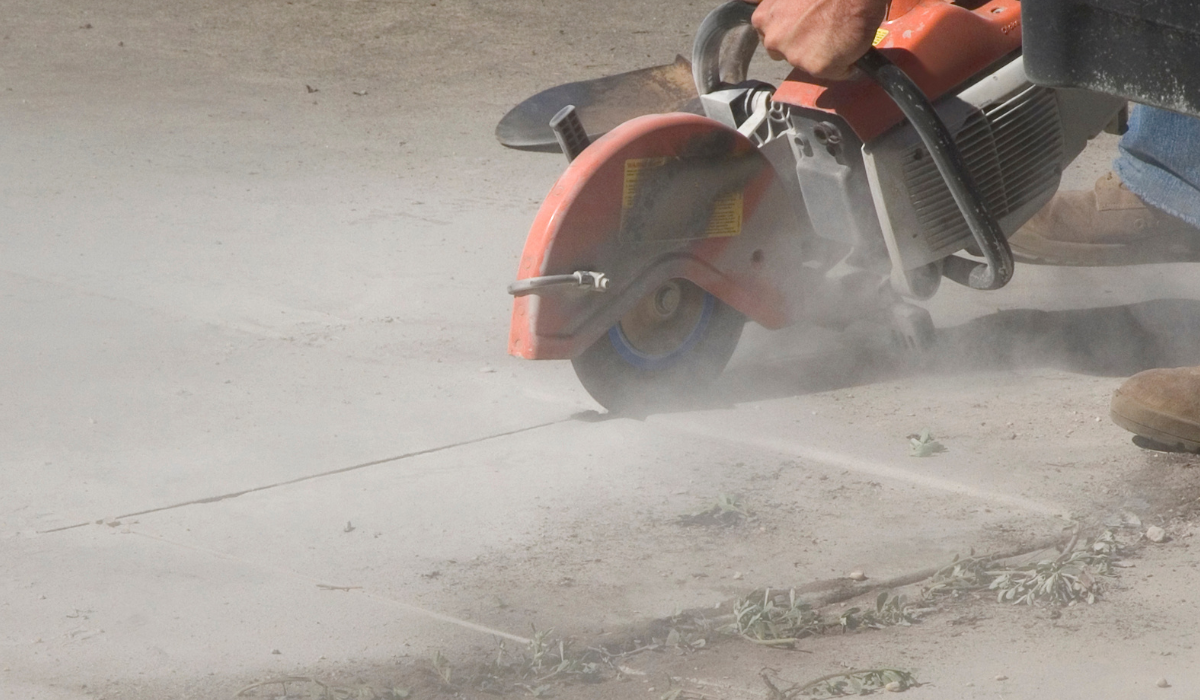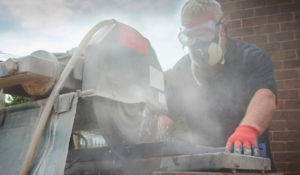Across numerous industries, silica dust protection is a critical component of workplace safety.
Typically, this dangerous, even deadly dust is generated during activities such as cutting, grinding, drilling, and crushing materials that contain crystalline silica, such as concrete, stone, and sand.
Since it’s 100 times smaller than a grain of sand, workers can breathe it in without realizing the dangers.
Breathing in silica dust can have severe health consequences, including respiratory diseases and lung cancer. And, approx. 2.3 million people in the U.S. are exposed to silica at work every year.
So, what are some of the dangers? More importantly, what do you need to know about silica dust protection for you and your team?
Let’s break it down.
Related Article: OSHA Targets Silica Hazards in Cut Stone Industry
Related Article: How to Protect Your Team from the Effects of Silica

Health Implications of Silica Dust Exposure
When inhaled, silica dust particles can penetrate deep into the lungs and cause various respiratory ailments.
Prolonged exposure to high levels of silica dust can lead to the development of silicosis, a debilitating and irreversible lung disease. Silicosis is characterized by the formation of scar tissue in the lungs, reducing their ability to function effectively.
Symptoms of silicosis include persistent cough, shortness of breath, chest pain, and fatigue.
In addition to silicosis, silica dust exposure is also associated with an increased risk of developing other respiratory conditions. These include chronic obstructive pulmonary disease (COPD), tuberculosis, lung cancer, and kidney disease. Furthermore, silica dust has been linked to an increased susceptibility to respiratory infections and exacerbation of existing respiratory conditions, such as asthma.
Related Article: NIOSH Takes Step toward Reducing Silica Dust Exposure in Mines
The Importance of a Workplace Respiratory Protection Program
Given the serious health risks posed by silica dust, it is crucial for workers to use appropriate respiratory protection measures to minimize their exposure. Respiratory protection can effectively reduce the inhalation of silica dust particles and safeguard the respiratory system. There are various types of respiratory protection equipment available, and the choice of the most suitable option depends on the nature of the work being performed.
For proper silica dust protection, your team should be equipped with one of the following.
1. N95 Respirators
N95 respirators are a common form of respiratory protection widely used in industries where workers are exposed to silica dust. These respirators filter out at least 95% of airborne particles, including silica dust, with a diameter of 0.3 micrometers or larger.
N95 respirators create a seal around the nose and mouth, ensuring that the air breathed in is properly filtered. Remember that for silica dust protection, it’s essential to conduct fit testing to ensure a proper fit.
2. Powered Air-Purifying Respirators (PAPRs)
PAPRs are another option for respiratory protection, particularly in situations where the concentration of silica dust is high.
PAPRs use a battery-powered fan to draw air through filters before delivering it to the wearer’s breathing zone. These respirators provide a higher level of protection than N95 respirators, and are more comfortable to wear for extended periods.
However, they require regular maintenance, including filter replacement and battery recharging.
3. Supplied Air Respirators (SARs)
SARs, also known as airline respirators, provide a continuous supply of clean air from a remote source.
They are suitable for environments with extremely high levels of silica dust or where the oxygen concentration is insufficient. SARs are typically used in confined spaces, such as underground mines or tunnels. These respirators offer excellent silica dust protection, they can sometimes restrict mobility due to the need for an air supply line.
Implementing an Effective Silica Dust Protection Program at Your Worksite
To ensure effective respiratory protection against silica dust, employers should establish comprehensive respiratory protection programs.
These programs should include the following elements:
1. Hazard Assessment
Employers must conduct a thorough assessment of workplace hazards to determine the extent of silica dust exposure. This assessment helps identify areas requiring respiratory protection and enables the selection of appropriate equipment.
2. Silica Dust Protection Training and Education
Workers should receive proper training on the risks associated with silica dust exposure, the proper use and maintenance of respiratory protection equipment, and the importance of following safe work practices. Regular refresher training sessions should be conducted to reinforce these principles.
3. Proper Equipment Selection
Employers should select respiratory protection equipment that meets the required standards and is appropriate for the specific work environment. This includes ensuring that respirators have the correct filter type and efficiency level for silica dust particles.
4. Fit Testing and Maintenance
Fit testing should be conducted to ensure that respirators fit properly and provide an effective seal. Regular maintenance, including inspection, cleaning, and replacement of filters, is essential to keep respiratory protection equipment in good working condition.
5. Monitoring and Evaluation
Regular monitoring of silica dust levels in the workplace is necessary to evaluate the effectiveness of control measures and identify any necessary adjustments or improvements to the respiratory protection program.
See OSHA’s guidelines on respirable crystalline silica- 1926.1153.
Bringing It Together
Protecting workers from the adverse effects of silica dust is essential for maintaining occupational health and safety. By understanding the health hazards associated with silica dust exposure and implementing appropriate respiratory protection measures, employers can safeguard the well-being of their workforce.
Respiratory protection programs, including proper equipment selection, fit testing, training, and maintenance, play a crucial role in mitigating the risks posed by silica dust, enabling workers to breathe safely and maintain their long-term respiratory health.
***
About Worksite Medical
In most cases, OSHA requires medical surveillance testing, and at no cost to employees.
Worksite Medical makes that program easier with mobile medical testing.
We conduct on-site respirator fit tests, as well as audiometric exams, pulmonary function tests and heavy metal lab work, right on your job site. We also keep accurate, easy-to-access medical records for your convenience. You’ll keep your employees at work, and stay ahead of OSHA inspections.
"*" indicates required fields




